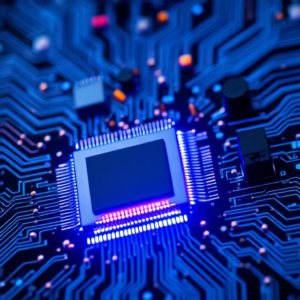Both microprocessors and microcontrollers play vital roles in modern technology, with microprocessors powering complex systems and microcontrollers controlling everyday devices.
The Microprocessor is often considered the “brain” of a general-purpose computer. It performs tasks such as fetching instructions from memory, decoding them, and executing them to complete a process. Microprocessors are found in devices that require complex computations and multitasking, such as:
- Desktop computers: Where the microprocessor runs the operating system and applications.
- Laptops and smartphones: For computing power and running apps.
- Gaming consoles: To manage game processing and interactions.

Parts of a Microprocessor:
- ALU (Arithmetic and Logic Unit): It performs mathematical and logical operations.
- Control Unit (CU): It fetches and decodes instructions and manages the operation of other components.
The Microcontrollers are designed to control specific tasks in embedded systems. They are self-contained systems, meaning they don’t need external components to function (other than power and input/output devices). Microcontrollers are widely used in everyday devices that don’t require complex operations, such as:
- Home appliances: Like microwave ovens, refrigerators, and washing machines.
- Cars: Microcontrollers manage functions like power windows, airbag systems, and engine control.
- Toys and gadgets: Used in toys, digital clocks, remote controls, and fitness trackers.
Parts of a Microcontroller:
- CPU (Central Processing Unit): Executes the instructions.
- Memory: Includes RAM(temporary storage for data) and ROM (permanent storage for the program).
- I/O Ports: These ports allow the microcontroller to communicate with sensors, actuators, and other devices.
- Timers and Counters: Used for precise time delays and measurements, often for controlling processes like timing in a microwave or washing machine.
Microcontroller: A microcontroller is like a specialized worker in a factory. This worker is assigned a specific task, like assembling a toy or controlling a machine. The worker is self-sufficient, with all the tools needed for the job built into their workstation (just like how the microcontroller has everything on a single chip).
Think of a microprocessor like a general-purpose worker in an office. This worker is capable of doing many tasks, such as answering emails, writing reports, or attending meetings. However, the worker needs other people (like a printer, a computer, or storage) to help complete the job.
Tags: Actuators, airbags, ALU, applications, Arithmetic and Logic Unit, central processing unit, complex systems, Computing Power, Control Unit, counters, CPU, CU, decoding, desktop computers, Digital Clocks, Embedded Systems, engine control, executing, fetching instructions, fitness trackers, gaming consoles, general-purpose computer, I/O ports, input/output devices, laptops, logical operations, mathematical operations, Memory, Microcontroller, Microprocessor, microwave ovens, Multitasking, Operating System, power windows, RAM, refrigerators, remote controls, ROM, Sensors, smartphones, specific tasks, Timers, toys, washing machines


